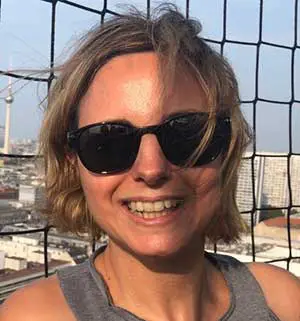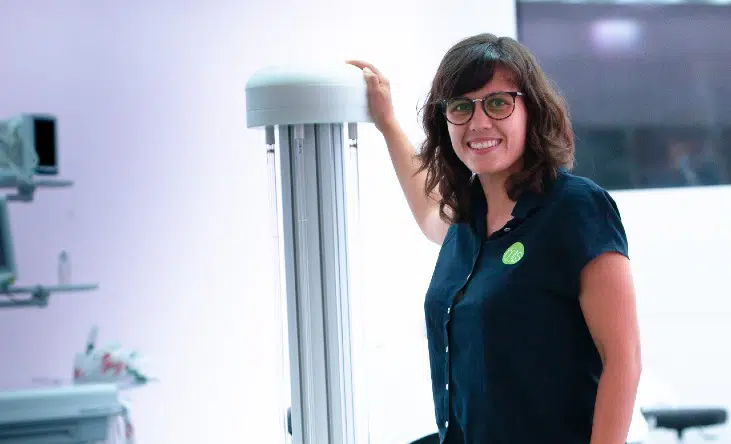INNOVATION| 20.08.2021
María Visa: “We have to humanize technology. And for that, we need women”

Marta Villalba
María Visa (Barcelona, 1989) always knew that she wanted her own company. After studying industrial design engineering—chosen because it opened the door to many fields and allowed her to develop her creativity—and completing two Master’s degrees, she worked for several industrial companies before co-founding Main Technical Solutions (MTSTech) in 2019, which specializes in automating intralogistics. That is, optimizing the internal operations of workplaces such as factories, hospitals and other centers using robotics.
MTSTech is at the forefront of developing autonomous robots that disinfect spaces with ultraviolet light. It’s not the only company using UV sterilization and robots to combat COVID-19, but it is one of the first to prove the effectiveness of its system against the virus, by collaborating with Hospital Clínic de Barcelona and the IRTA-CReSA (Centro de Investigación en Sanidad Animal — Animal Health Research Center) to carry out the “real world” testing necessary to obtain the certification required to operate in other hospitals.
“We kind of got started by chance. In the summer of 2019, we were in the early stages of developing a mobile robotics product to disinfect cleanrooms and pharmaceutical packaging when the pandemic arrived. There are similar robots being used for the same purpose, but ours are much smarter and we’re well ahead in terms of certification. We have been pioneers in being able to conduct a “real world” trial that proves the efficacy of our machine in stopping COVID-19,” explains María Visa. The entrepreneur points out that her system goes beyond the pandemic because it also eliminates the germs causing hospital-acquired infections, which would avoid some of the 3,200 deaths that occur in Spain every year due to such infections. “The obstacle to using robots more than we do is the bureaucracy that comes with it,” says María Visa.
While her company accomplishes this slow task of changing the internal protocol of Hospital Clínic de Barcelona to allow the machine to be used there and replicate this in many other hospitals, the engineer continues to study, first, the possibility of reducing the size of the equipment, and second, checking if a wavelength of 222 nm (nanometers) has the same germicidal power as the 254 nm wavelength currently used, because the former is not harmful to people. But 254 nm is, meaning that before her robot disinfects a space, it ensures that it is empty. The engineer clarifies that her machine does not replace manual cleaning: “If the room is dirty, with a layer of dust on top of the surface that needs to be disinfected, it won’t be disinfected.”
As a professor at Elisava (University School of Design and Engineering of Barcelona), María Visa sees an urgent need to apply robotics to help older people because “we have an increasingly aging society with an ever-growing need for care.” In the expert’s view, this is one area where we should be dedicating a lot of resources. “At the university, we do a lot of work on humanizing robotics, we have to make it more human. I believe that women will play a key role in this. The fact that more and more women engineers are getting involved in robotics is going to really help add this human dimension to caring for older people. This is a big challenge. We need to design solutions based on empathy. Women have their strengths and weaknesses like everyone else, but historically we’ve always had more empathy. If we can bring this way of looking at things and added value with us, it will lead to some very important technology.”

In terms of caring for the older population, María Visa regrets that there is still a long way to go before seeing business developments, although she’s certain that this will change: “We’re still at a very early stage. It’s true that many research projects are being conducted at universities and research centers, but I get the impression that most are theoretical, rather than applied. But I also believe this will change because, if we look at it from an economic perspective, soon, if not already, this sector will be very profitable for companies. So, I think that more and more companies will invest in developing new products and solutions for this age group and for this sector of society.”
Her company is already collaborating on this, with a project to automate the collection of dirty clothes and delivery of clean ones in a care home in Catalonia with a mobile robot, so that the staff can focus on tasks that are of greater benefit to the residents. “Too few people dedicate time and thought to how they could help in care homes or the homes of people living alone, or even to consider how the community model changes after a certain age. It’s exciting to be able to reflect and help older people.”
On the subject of why women are a minority in technical careers, María Visa finds sociocultural norms the greatest obstacles (“boys play with cars and girls play with dolls or kitchens”), although she’s also optimistic that “this is changing for the new generations. Women in engineering courses are still in the vast minority, but the numbers keep getting better.” The basis for promoting the vocation must be education from a young age, she says. “We have to give girls more role models and avoid setting them down a path; everyone should decide for themselves what motivates them. And on the flipside, more men are needed in the education sector.”
MTSTech’s co-founder encourages young people to study engineering as they can go on to work in any industry and tells them not to be afraid, engineering is not necessarily more difficult than any other career; it all depends on what motivates you: “Engineering wasn’t difficult for me, but if I’d studied law, it would have been.”
For María Visa, being one of the few female entrepreneurs in the robotics field has worked to her advantage “in terms of media and positioning. The fact that there are virtually no women in this sector has worked as a sort of affirmative action. Sometimes being one of the first is an advantage too. If we want to have role models, we need to create these role models.”
